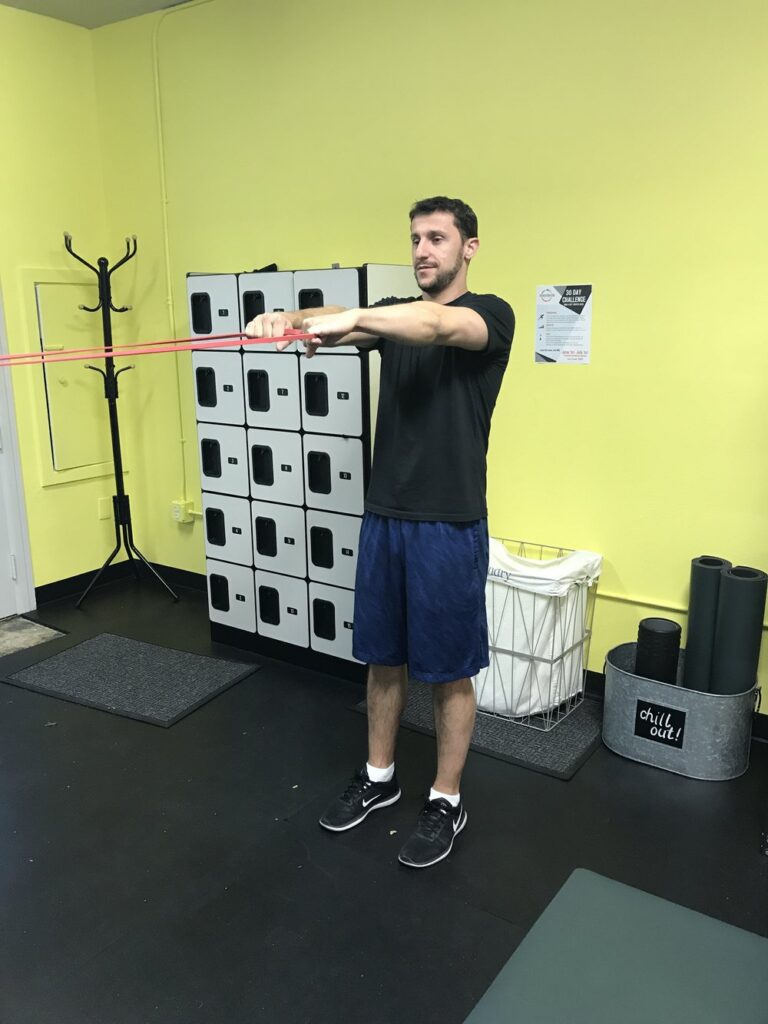One of the most common imbalances I see in new clients is upper cross syndrome. Muscular dysfunctions such as these can often lead to poor exercise technique, poor posture, compensation patterns, and even injuries.
UCS is the tightness of the upper traps and levator scapulae (upper back muscles) as well as tightness of the pectoralis major and minor (chest muscles). To go along with tightness in these areas are weak deep cervical flexors (neck muscles) and weak middle and lower traps (mid-lower back muscles). Muscles are interconnected and if one muscle group becomes weak another becomes tight. This “cross” of tightness and weakness creates the conditions of UCS.
Common symptoms of UCS include forward head posture, rounded shoulders, shoulder pain, headache, improper breathing, and a hunched upper back (kyphosis). UCS can be the result of years of sitting with bad posture, poor exercise technique (e.g. biking with rounded upper back position), and imbalanced training (e.g. someone who trains their chest often while the upper back is rarely trained).
So what can you do about it? I’ve outline 5 things you can do to mitigate UCS.
1. Stretching of the chest and anterior deltoid.
There are many great stretches for the chest and anterior deltoids. Here are a few basic ones to get you started.
The PVC stretch – One way of doing this stretch is to bring the PVC over the head as far as possible until you feel a stretch across the front of the shoulders and chest. Slowly lower the bar to your lower back. Do 1 set of 10-15 reps.
The squat rack pec stretch – Bracing the bottom of your palms against a squat rack frame, stick your chest out, draw your shoulder blades together, and lean forward while pointing your finger tips behind you to feel a stretch across the pectoral and anterior deltoid region. You can do this with one arm or both arms at once. Vary the height of your hands relative to the upper body to shift emphasis of the stretch. Hold for 60 seconds.

Wall Angels – Wall angels targets the muscles in the thoracic spine region and opens up tight chest muscles. This mobility exercise also increase the range of motion in the shoulder joint. Below is a great video of wall angles that you can practice at the gym, office, and home.
2. Myofascial release. The goal with self-myofascial release is to improve the quality and extensibility of soft tissue. By working deliberately and massaging the target area, we can affect the resting tone of soft tissue and help to free up chronically tight muscles. Place a lacrosse ball on various positions on the pec major and minor. Working from the middle outwards, slowly apply pressure and massage the chest. I like to use the side of a doorway or squat rack. Below is a great instructional video.
3. Strengthen the back.
Face pulls – Face pulls strengthen and reactivate the scapula stabilizers. Facing a high pulley with a band attached, pull the band directly towards your chin, separating your hands as you do so. Keeping your upper arms parallel to the ground. Stand in a straight line and “tuck the ribs in” so that you avoid any hyperextension of the spine. Complete 3 sets of 12-15 three times a week.


TRX rows – Adjust the TRX straps to your height. Set your body in a straight line, as if you were in a plank position. While keeping your arms straight, walk your feet forward until there is tension in the straps. Make sure to keep your palms facing each other in a hammer grip. This is starting position. To begin the movement, retract your shoulder blades back and down. Now, pull your torso towards your hands keeping your elbows close to your body. Your body should remain in a plank and your palms and wrists should stay neutral. Lower your body back to the starting position and repeat. If the exercise is too easy, move the feet a bit farther forward.


One arm row – To perform the exercise with your left arm, position your right knee and right hand on a bench. Leave your left foot flat on the floor and bend forward so your torso is horizontal. Hold the dumbbell in a hammer grip and your arm extended straight down. This is the starting positon. Lift the weight to the left side of your chest while keeping both shoulders leveled with each other. Keep your back flat while your core keeps you from moving your torso. Lower the weight slowly to the starting position. Perform the exercise with both arms.


4. Do 2 back exercises for every 1 chest exercise. In the beginning try integrating 2 back exercises for every chest exercise. Over time you can balance this out more as USC improves.
5. Better posture while working. Many offices are getting better at implementing ergonomics and giving their employees comfortable working areas. For your work area at home you don’t need to spend hundreds of dollars on a great chair (unless you can afford it). You simply need a chair that has an adjustable height so you can set your feet comfortably on the floor, a solid cushion to sit on, and good lower back support. You want the height of your monitor to be such that you can look straight ahead and not have to adjust your neck angle to view the screen. Even stacking some books under you monitor should do the trick.
